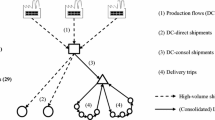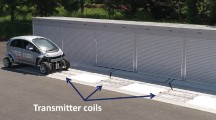Abstract
The booming development of e-commerce has brought about rapid growth in the express delivery industry in China. However, urban express distribution is increasingly difficult and seriously affecting the traffic, safety, and environmental conditions of cities due to small, scattered end points, unreasonable allocation of resources, and seriously repeated resource waste. Therefore, there is an urgent need to solve the problems associated with the unreasonable resource allocation of express distribution. In the context of green logistics, a new mode of collaborative distribution based on intelligent end service station (IESS) is proposed. Following the measurement models of carbon emissions, before and after collaborative distributions are provided to prove the environmental benefits of the new mode. The influencing factors considered in the models are the average daily distribution volume, number of distribution sections, vehicle ownership of various types, and their capacity, use, fuel, and power consumption. To verify the models’ validity, we conduct an empirical study of five express enterprises in China and make a comparative analysis on the results, which show that the implementation of collaborative distribution can extremely reduce carbon emissions and improve the overall load rate of vehicles. Specially, the use of new energy vehicles can contribute significantly to energy conservation and emissions reduction.






Similar content being viewed by others
References
Alshehry AS, Belloumi M (2017) Study of the environmental Kuznets curve for transport carbon dioxide emissions in Saudi Arabia. Renew Sust Energ Rev 75:1339–1347
Benjaafar S, Li YZ, Daskin M (2013) Carbon footprint and the management of supply chains: insights from simple models. IEEE Trans Autom Sci Eng 10(1):99–116
Beijing Municipal Postal Administration (2016) Beijing Municipal Postal Administration announced the operation of the whole SPI: City.’s postal industry in September 2016. http://bj.spb.gov.cn/xytj_14733/tjxx_14735/201610/t20161019_883859.html (in Chinese) Accessed on October 19, 2016
Chu ZF, Feng B, Lai FJ (2018) Logistics service innovation by third party logistics providers in China: aligning guanxi and organizational structure. Transp Res Part E Logist Transport Rev 118:291–307
Dai A, Zhou X, Liu X (2017) Design and simulation of a genetically-optimized fuzzy immune PID controller for a novel grain dryer. IEEE Access 5:14981–14990
Dai Y, Gao HO (2016) Energy consumption in China’s logistics industry: a decomposition analysis using the LMDI approach. Transp Res Part D Transp Environ 46:69–80
Danish, Baloch MA, Suad S (2018) Modeling the impact of transport energy consumption on CO2 emission in Pakistan: evidence from ARDL approach. Environ Sci Pollut Res 25(10):9461–9473
Fan W, Xu M, Dong X, Wei H (2017) Considerable environmental impact of the rapid development of China’s express delivery industry. Resour Conserv Recycl 126:174–176
Franceschetti A, Honhon D, Van Woensel T, Bektaş T, Laporte G (2013) The time-dependent pollution-routing problem. Transp Res Part B Methodol 56:265–293
Gan M, Liu X, Chen S, Yan Y, Li D (2018) The identification of truck-related greenhouse gas emissions and critical impact factors in an urban logistics network. J Clean Prod 178:561–571
Gong Y, Chen LJ, Jia F, Wilding R (2019) Logistics innovation in China: the Lens of Chinese Daoism. Sustainability 11(2):545. https://doi.org/10.3390/su11020545
Guo J, Ma S (2017) Environmental impact assessment for city logistics distribution systems. Environ Eng Res 22(4):363–368
Guo XP, Ren DF, Shi JX (2016) Carbon emissions, logistics volume and GDP in China: empirical analysis based on panel data model. Environ Sci Pollut Res 23(24):24758–24767
Jara D (2000) The effect of using aggregated output in the economic analysis of cargo handling operations. Contrib Econ 21(3):97–109
Juskowiak TE, Wharton JF (2004) Joint and expeditionary logistics for a campaign-quality army. Army Logistician 36(5):181–203
Khan SAR, Dong QL (2017) Does national scale economic and environmental indicators spur logistics performance? Evidence from UK. Environ Sci Pollut Res 24(34):26692–26705
Khan SAR (2019) The nexus between carbon emissions, poverty, economic growth, and logistics operations-empirical evidence from southeast Asian countries. Environ Sci Pollut Res 26(13):13210–13220
Kishino K, Ikarashi Y (2010) Quantitative evaluation of the effect of the environmental impact (vehicles, mileage, running time) by using joint delivery and delivery to specified delivery time. Bull Niigata Univ Int & Inf Studies Depart Inf Cult 13:85–102
Kucukoglu I, Ene S, Aksoy A, Ozturk N (2015) A memory structure adapted simulated annealing algorithm for a green vehicle routing problem. Environ Sci Pollut Res 22(5):3279–3297
Lee K (2011) Integrating carbon footprint into supply chain management: the case of Hyundai Motor Company (HMC) in the automobile industry. J Clean Prod 19(11):1216–1223
Lee K, Cheong I (2011) Measuring a carbon footprint and environmental practice: the case of Hyundai Motors Co. (HMC). Ind Manag Data Syst 116:961–978
Li Y, Tan W, Sha R (2016) The empirical study on the optimal distribution route of minimum carbon footprint of the retail industry. J Clean Prod 112:4237–4246
Lin C, Choy KL, Ho GTS, Chung SH, Lam HY (2014) Survey of green vehicle routing problem: past and future trends. Expert Syst Appl 41(4):1118–1138
Liu J, Yuan C, Hafeez M, Yuan Q (2018) The relationship between environment and logistics performance: evidence from Asian countries. J Clean Prod 204:282–291
Macharis C, Melo S, Woxenius J, Van Lier T (2014) Sustainable logistics. Emerald Group Publishing, Bingley
Montoya-Torres JR, Munoz-Villamizar A, Vega-Mejia CA (2016) On the impact of collaborative strategies for goods delivery in city logistics. Prod Plan Control 27(6):443–455
Murphy P, Poist R (2000) Green logistics strategies: an analysis of usage patterns. Transp J 40(2):5–16
Ramanathan U, Bentley Y, Pang G (2014) The role of collaboration in the UK green supply chains: an exploratory study of the perspectives of suppliers, logistics and retailers. J Clean Prod 70:231–241
Ramos TRP, Gomes MI, Barbosa-Póvoa AP (2014) Planning a sustainable reverse logistics system: balancing costs with environmental and social concerns. Omega 48:60–74
Sadrnia A, Ismail N, Zulkifli N, Ariffin M, Nezamabadi-pour H, Mirabi H (2013) A multiobjective optimization model in automotive supply chain networks. Math Probl Eng 2013:823–876
Shaw K, Shankar R, Yadav SS, Thakur LS (2013) Modeling a low-carbon garment supply chain. Prod Plan Control 24(8–9):851–865
Shouket B, Zaman K, Nassani AA, Aldakhil AM, Abro MMQ (2019) Management of green transportation: an evidence-based approach. Environ Sci Pollut Res 26(12):12574–12589
Sim J, Sim J (2017) Air emission and environmental impact assessment of Korean automotive logistics. J Clean Prod 159:130–140
Srivastava SK (2007) Green supply-chain management: a state-of-the-art literature review. Int J Manag Rev 9(1):53–80
State Post of Bureau of The People’s Republic of China (2020) State Post of Bureau announced the operation of postal industry in 2019. http://www.spb.gov.cn/xw/dtxx_15079/202001/t20200114_2005598.html (in Chinese). Accessed 14 Jan 2020
Sun Q (2017a) Empirical research on coordination evaluation and sustainable development mechanism of regional logistics and new-type urbanization: a panel data analysis from 2000 to 2015 for Liaoning Province in China. Environ Sci Pollut Res 24(16):14163–14175
Sun Q (2017b) Research on the influencing factors of reverse logistics carbon footprint under sustainable development. Environ Sci Pollut Res 24(29):22790–22798
Talbi B (2017) CO2 emissions reduction in road transport sector in Tunisia. Renew Sust Energ Rev 69:232–238
Taniguchi E, Noritake M, Yamada T (1999) Optimal size and location planning of public logistics terminals. Transp Res Part E Logist Transport Rev 35(3):207–222
Ubeda S, Arcelus FJ, Faulin J (2011) Green logistics at Eroski: a case study. Int J Prod Econ 131(1):44–51
Wang DF, Dong QL, Peng ZM, Khan SAR, Tarasov A (2018) The green logistics impact on international trade: evidence from developed and developing countries. Sustainability 10(7):2235. https://doi.org/10.3390/su10072235
Wang J, Lim M, Tseng M, Yang Y (2019a) Promoting low carbon agenda in the urban logistics network distribution system. J Clean Prod 211:146–160
Wang K, Shao Y, Zhou W (2017a) Matheuristic for a two-echelon capacitated vehicle routing problem with environmental considerations in city logistics service. Transp Res Part D-Transport and Environ 57(11):262–276
Wang Y, Ma XL, Li ZB, Liu Y, Xu MZ, Wang YH (2017b) Profit distribution in collaborative multiple centers vehicle routing problem. J Clean Prod 144:203–219
Wang Y, Assogba K, Fan JX, Xu MZ, Liu Y, Wang HZ (2019b) Multi-depot green vehicle routing problem with shared transportation resource: integration of time-dependent speed and piecewise penalty cost. J Clean Prod 232:12–29
Xie X, Shao S, Lin B (2016) Exploring the driving forces and mitigation pathways of CO2 emissions in China’s petroleum refining and coking industry: 1995–2031. Appl Energy 184:1004–1015
Yang JH, Guo JD, Ma SG (2016) Low-carbon city logistics distribution network design with resource deployment. J Clean Prod 119:223–228
Zhang KY, Liu XM, Yao JM (2019) Identifying the driving forces of CO2 emissions of China's transport sector from temporal and spatial decomposition perspectives. Environ Sci Pollut Res 26(17):17383–17406
Zhang Z, Figliozzi MA (2010) A survey of China’s logistics industry and the impacts of transport delays on importers and exporters. Transp Rev 30(2):179–194
Zhao Q, Wang W, De Souza R (2017) A heterogeneous fleet two-echelon capacitated location-routing model for joint delivery arising in city logistics. Int J Prod Res 56(15):5062–5080
Funding
This research was funded by the Fundamental Research Funds of Beijing University of Posts and Telecommunications, grant number 2018XKJC07 and National Development and Reform Commission, grant number JM-19-3-4.
Author information
Authors and Affiliations
Corresponding author
Ethics declarations
Conflict of interest
The authors declare that they have no conflict of interest.
Additional information
Responsible Editor: Nicholas Apergis
Publisher’s note
Springer Nature remains neutral with regard to jurisdictional claims in published maps and institutional affiliations.
Rights and permissions
About this article
Cite this article
Bi, K., Yang, M., Zhou, X. et al. Reducing carbon emissions from collaborative distribution: a case study of urban express in China. Environ Sci Pollut Res 27, 16215–16230 (2020). https://doi.org/10.1007/s11356-020-08143-2
Received:
Accepted:
Published:
Issue Date:
DOI: https://doi.org/10.1007/s11356-020-08143-2




